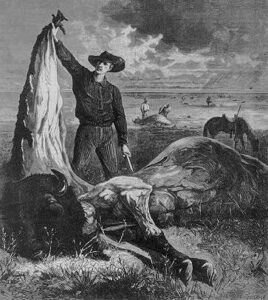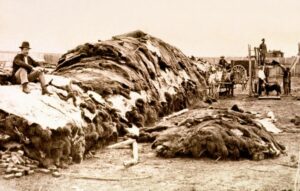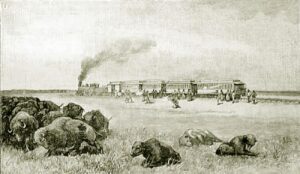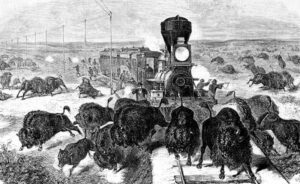
 It is amazing to me that the ideas of one person can change the world, a nation, state, or city. Sometimes the changes are good, and sometimes they are horrible. During the early years of the Old West, besides fighting with the American Indians, there were those who felt like the buffalo were a big problem too. General Philip Sheridan said, “Let them kill, skin, and sell until the buffalo is exterminated, as it is the only way to bring lasting peace and allow civilization to advance.” His idea created a frenzy of hunters, intent on ridding the country of the buffalo. The buffalo, at that time an estimated 50-60 million of them, roamed freely in the Great Plains before white settlers began to push into the vast west in any great numbers. The buffalo were a vital food source for the American Indians hunted them for food and other necessities, and a harmonious ebb and flow between man and beast prevailed.
It is amazing to me that the ideas of one person can change the world, a nation, state, or city. Sometimes the changes are good, and sometimes they are horrible. During the early years of the Old West, besides fighting with the American Indians, there were those who felt like the buffalo were a big problem too. General Philip Sheridan said, “Let them kill, skin, and sell until the buffalo is exterminated, as it is the only way to bring lasting peace and allow civilization to advance.” His idea created a frenzy of hunters, intent on ridding the country of the buffalo. The buffalo, at that time an estimated 50-60 million of them, roamed freely in the Great Plains before white settlers began to push into the vast west in any great numbers. The buffalo were a vital food source for the American Indians hunted them for food and other necessities, and a harmonious ebb and flow between man and beast prevailed.
That was about to change after the Civil War, as more and more people moved westward. As the migration progressed, new army posts were established, and at the same time came the need for food and supplies for the soldiers. So, the army contracted with local men to supply buffalo meat to feed the troops. Then came the construction workers for the railroad, and a greater need for food. General Sheridan considered the buffalo a nuisance animal, as so was all for the slaughter of the buffalo. The buffalo coats could also supply the army and contractors with buffalo robes that could be used as coats and lap robes when riding in sleighs and carriages. These events put many a man to work as buffalo hunters. Because many people needed work, the offer of work came as a welcome prospect.
Leavenworth, Kansas, soon became a trading center for the buffalo hides, and tanneries found even more, uses for the material. Soon, things such as drive belts for industrial machines and grinding buffalo bones into fertilizer because common practices. In some places, buffalo tongues became a delicacy in fine restaurants. Personally, I would have to call things like at that one…disgusting!! Even though I know that some people like them. Before long the demand was so high that year-round work was available for buffalo hunters.
At the time of this offering, the economy was depressed after the Civil War, so many of the “tough” men decided to earn their living as a buffalo hunter. They had families to support, and so they went out, armed with powerful, long-range rifles. Each individual hunter could kill as many as 250 buffalo a day. Tanneries paid as much as $3.00 per hide and 25¢ for each tongue, which made a nice living for hundreds of men, including Wyatt Earp, Bat Masterson, Pat Garrett, Wild Bill Hickok, and William F Cody, just to name a few. Sadly, the meat wasn’t treated as well. All they wanted were the hides and tongues, so the rest of the edible buffalo meat was often left to rot on the Plains. Such a horrific waste. Over 5,000 hunters and skinners were involved in the trade by the 1880s.
Of course, to the Indians, this horrific slaughter was as heinous a crime as there ever could be. The majestic buffalo, who had often given their lives to supply the tribe with much needed food and blankets were being killed as if it was nothing more than sport. The air took on an almost carnival atmosphere when railroads began to advertise “hunting by rail.” Whenever the trains encountered a herd of buffalo crossing the tracks, it started a shooting spree. The sporting men would shoot hundreds of buffalo for fun, and then the trains would roll away, leaving the dead animals where they fell.
As you would expect, the Indians grew more and more angry and this senseless slaughter. They were, after all, watching their main source of food laying waste on the prairie. Their anger led to more Indian attacks on the White Man, which resulted in US Army retaliation at the height of the Indian Wars. Before long, the US Government decided that they needed to separate the Indians from the rest of “civilization” by placing them on reservations. To force the Indians onto the reservations, they needed to get rid of most of their food source, so US Army aggressively pursued a policy to eradicate the buffalo, which would force them onto reservations in order to survive.
Finally, the Texas Legislature began discussing a bill to protect the buffalo. Of course, General Sheridan defended the buffalo hunters and opposed the bill by saying, “These men have done more in the last two years and will do more in the next year to settle the vexed Indian question than the entire regular army has done in the last forty years. They are destroying the Indians’ commissary. And it is a well-known fact that an army losing its base of supplies is placed at a great disadvantage. Send them powder and lead, if you will, but for lasting peace, let them kill, skin, and sell until the buffalos are exterminated. Then your prairies can be covered with speckled cattle.”
Finally, in 1884 the era of the buffalo slaughter ended, and nothing remained of the massive buffalo herds but 
 piles of bones. By then, there were only about 1,200-2,000 surviving buffalo left in the United States. Through the continuing management efforts, there are currently 500,000 buffalo in the United States, including about 5,000 in Yellowstone and 1,000 in the Black Hills. These days, there are buffalo in every state.
piles of bones. By then, there were only about 1,200-2,000 surviving buffalo left in the United States. Through the continuing management efforts, there are currently 500,000 buffalo in the United States, including about 5,000 in Yellowstone and 1,000 in the Black Hills. These days, there are buffalo in every state.


Leave a Reply